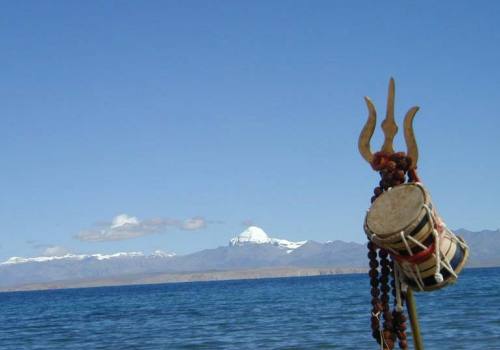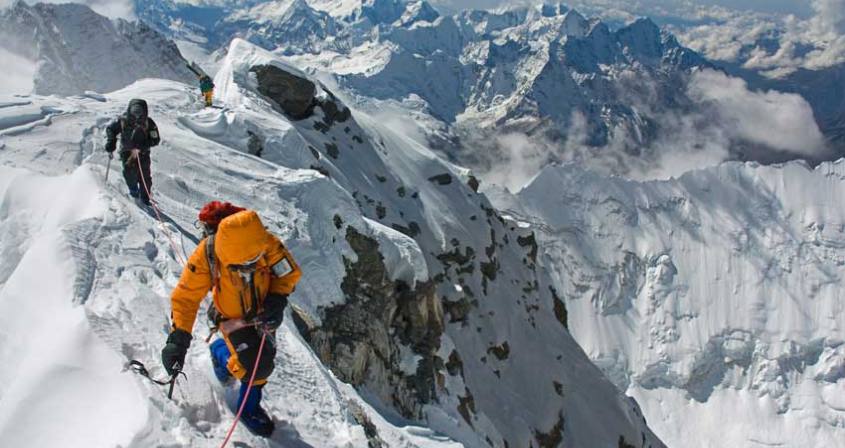Everest Expedition
About Trip -
Mt Everest (8848m), the highest mountain of the world, climbing has proved to be a benchmark of climbing achievement. Being in Everest is lifetime dream of every human being. Climb to the top of the Everest is lifetime experience for every mountain lovers and adventure seekers to the mountain range. The mountain receives around 1000 summit attempts every year. Everest can be climbed both from the southern side Nepal and northern side Tibet. After the Cultural Revolution in the 1950s, China closed the Tibet borders to outsiders and Nepal began welcoming foreigners to the Everest Region. Since then the southern approach to the mountain via the Khumbu Valley became popular among the climbers. Mt. Everest was first summitted in 1953 by Tenzing Norgay Sherpa and Edmund Hillary via the South Col. Climbing Mt. Everest is certainly a lifetime opportunity. However, Everest expeditions encounter many seen and unseen obstacles including high altitude, harsh weather conditions and even sheer exhaustion. Therefore, we strive hard to conduct the best expedition program putting high importance on the safety aspects of the climb.
Despite being the highest mountains on planet Earth, the Himalayan range of mountains including Mt. Everest are relatively younger than their American and European counterparts like the Andes, the Alps, and the Rockies. The Everest has fascinated the mountaineers all over the world since the European climbers discovered the Everest when Tibet was opened to outsiders in the 1920s. During his lecture tour to the U.S. in 1923, George Mallory gave the reason behind his interest in Everest Expeditions quipping, 'Because it's there'. Unfortunately, Mallory and Irvine disappeared high on the mountain in 1924 probably due to a snow storm similar to that documented by Jon Krakauer in his book Into the Thin Air. We believe that our planning, logistics, staffing and experience coupled with your enthusiasm, patience, and perseverance would help you achieve your lifetime dream.
Outline Itinerary -
Day 01:Arrival in Kathmandu International airport and meet with representative of Pink Mountain Treks and Expedition, then transfer to hotel.
Day 02:Kathmandu (1350m) sightseeing tour
Day 04:Fly to Lukla & Trek to Phakding - 2,840m/9,315ft
Day 05:Trek to Namche Bazar
Day 06:At leisure in Namche Bazar
Day 07:Trek to Thyangboche
Day 08:Trek to Dingboche
Day 09:Acclimatization
Day 14:Trek to Lobuje
Day 15:Trek to Everest Base Camp
Day 16:Rest and preparation
Day 19:Ascent of Mt Everest
Day 65:Withdraw to Base Camp
Day 66:Return trek to Namche Bazaar via Dingboche and Thyangboche
Day 69:Trek to Lukla
Day 70:Fly Lukla to Kathmandu
Day 71:Fly out. Pink Mountain Treks and Expedition's representative will drop you at airport before Three hours of your flight schedule.
Customize TripDetail Itinerary
Day 1Arrival in Kathmandu International airport and meet with representative of Pink Mountain Treks and Expedition, then transfer to hotel.
Day 2Kathmandu (1350m) sightseeing tourAfter breakfast, proceed to sightseeing tour to heritage sites of Kathmandu. Visit to Boudhanath stupa, Pashupatinath temple, Swayambhunath Stupa and Kathmandu durbar square tour.
Preparation and Briefing for Departure to Everest Region
This day is busy day for briefing about expedition, documentation and last minute shopping and preparation for departure to the trekking and climbing route. You will be kept in get set position.
Day 4Fly to Lukla & Trek to Phakding - 2,840m/9,315ftAn early morning scenic flight to Lukla. The mountain flight over to Lukla is one of the most beautiful air routes in the world culminating in a dramatic landing on a hillside surrounded by high mountains peaks. In Lukla, we will meet our camp staff and porters.After meeting our other crew members and with some packing and arrangements, we start our trek through the prosperous village of Lukla until we reach Phakding. Phakding lies on the main trade route through the area and there are a number of clean well-built lodges where we can spend the night.
Day 5Trek to Namche BazarContinue up the banks of the Dudh Kosi, crossing it twice by small suspension bridges before reaching the village of Monjo where we will enter the Khumbu National Park. Cross the confluence of the Dudh Kosi and the Bhote Kosi on a high suspension bridge and climb steeply for about two hours to reach Namche Bazaar. This is a prosperous trading town and the capital of the Khumbu region with genuine Tibetan artifacts.
Day 6At leisure in Namche BazarWe spend a day in Namche Bazar resting and allowing our bodies to become acclimatized to the altitude of 3,450m (11,300ft).Although a leisure day, it's important not to remain idle. Health experts always recommend us to stay active and moving during the rest day too instead of being idle. We either spend the day taking a day hike to Thame or visiting Khunde or relaxing and exploring Namche Bazaar itself. Namche Bazzar is the main centre of the Everest (Khumbu) region and has government offices, ATMs, Internet cafes, shops, restaurants, a bakery and a colorful market each Friday evening and Saturday. If we trek a few hundred vertical feet during the day, it will help us to properly acclimatize. Our guides will take us to the Tourist Visitor Center near the headquarter of the Sagarmatha National Park where we can observe an assortment of things related to the first Everest ascenders, Sherpa culture and learn about the various plant and animal life of the Everest region.
Day 7Trek to ThyangbocheThe well worn Everest trail contours around the side of the valley high above the Dudh Kosi. Follow the path, savoring the first really good views of the great peaks of the Khumbu: Everest, Lhotse, Nuptse and Ama Dablam. Passing by several villages and numerous tea shops, cross the Dudh Kosi River and make a steep climb to Thyangboche, home of an impressive and newly rebuilt monastery.
Day 8Trek to DingbocheWe pass through several Chortens and Mani walls and small villages. We enjoy lunch with fantastic close-up views of Ama-Dablam. Shaded by rhododendron trees, the path leads gradually down to the river once again to another airy suspension bridge. An hour's walking from here brings us to Pangboche, an excellent viewpoint for Ama Dablam. Contouring up the valley side, re-cross the river and turn up the Imja valley to reach the picturesque farming village of Dingboche.
Day 9AcclimatizationThis is an important phase of the expedition. Dingboche is a good location for acclimatization. The team leader will organize daily outings to the adjacent hills with the aim of providing gradual acclimatization. Walk some of the nearby hills in order to slowly increase exposure to altitude. Follow the regime that you have previously found most suitable, in order to give you maximum acclimatization before arrive in base camp.While in Dingboche, we can attend a seminar on high altitude acclimatization at a hospital run by the Himalayan Rescue Association nearby Pheriche. The walk over to Pheriche and back will also serve as good acclimatization training.
Day 14Trek to LobujeRetrace back to Pheriche before continuing up the trail towards base camp. Reach Dugla situated below the snout of the Khumbu Glacier, a convenient place for lunch. After lunch, the trail starts steeply to climb up beside the glacier moraine. After a couple of hours the track eventually leads to a small cluster of tea houses pleasantly situated at Lobuje.
Day 15Trek to Everest Base CampContouring along the valley-side and looking down on the Khumbu Glacier, follow a reasonable trail to Gorak Shep. This was the site of the base camp in 1953 and now consists of a few small tea houses. Leaving Gorak Shep, the trail leads on to the moraine of the Khumbu Glacier and becomes quite vague, weaving between mounds of rubble and eventually reaching base camp near the foot of the Khumbu Icefall. This will be our home for the next six weeks.
Day 16Rest and preparation
Day 19Ascent of Mt Everest
Day 65Withdraw to Base CampAll team members return to base camp and assist with packing expedition stores and cleaning the base camp area.
Day 66Return trek to Namche Bazaar via Dingboche and Thyangboche
Day 69Trek to Lukla
Day 70Fly Lukla to KathmanduFly back to Kathmandu from Lukla. Once back in Kathmandu, Pink Mountain Treks and Expedition will host an evening barbecue to celebrate the expedition and as a farewell party to thank the Sherpas for their support and friendship.
You can extend your trip in Nepal to explore the Jungle safari in Chitwan National park or Buddhist Pilgrimage trip to Lumbini, Birthland of Buddha or other part of Nepal's Trip or Can take your Flight to your destination.
Day 71Fly out. Pink Mountain Treks and Expedition's representative will drop you at airport before Three hours of your flight schedule.
Fixed Departure

Kailash Mansarovat tour with Pink Mountain Treks and Expedition let you to feel most memorable adventure trip of the life.…
In Detail